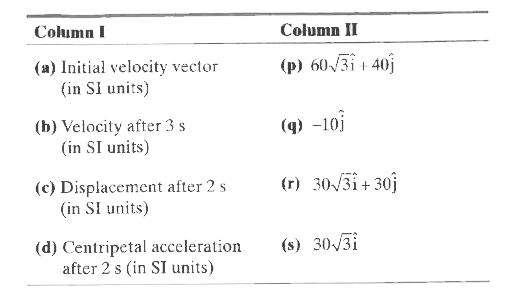A body is projected from the ground with some speed at some angle with the horizontal. Taking the horizontal and vertical direction to be x and y axis respectively and the point of projection as origin, calculate the minimum speed (in ms−1) of projection so that it can pass through a point whose x and y coordinates are 30 m and 40 m respectively? Take g=10ms−2
The correct Answer is:30
To solve the problem of finding the minimum speed of projection for a projectile to pass through the point (30 m, 40 m), we will follow these steps:
Step 1: Understand the motion of the projectile
The horizontal and vertical motions of the projectile can be described by the following equations:
- Horizontal motion: x=ucosθ⋅t
- Vertical motion: y=usinθ⋅t−12gt2
Where:
- u is the initial speed of projection
- θ is the angle of projection
- g is the acceleration due to gravity (given as 10m/s2)
- t is the time of flight
Step 2: Express time t in terms of x
From the horizontal motion equation, we can express time t as:
t=xucosθ
Substituting x=30m:
t=30ucosθ
Step 3: Substitute t into the vertical motion equation
Now we substitute t into the vertical motion equation:
y=usinθ⋅(30ucosθ)−12g(30ucosθ)2
Substituting y=40m and simplifying:
40=30tanθ−12g(302u2cos2θ)
Substituting g=10:
40=30tanθ−4500u2cos2θ
Step 4: Rearranging the equation
Rearranging the equation gives:
30tanθ−40=4500u2cos2θ
Let tanθ=t:
30t−40=4500u2(1+t2)
Step 5: Solve for u2
Rearranging gives:
u2=4500(30t−40)(1+t2)
Step 6: Find the minimum value of u2
To find the minimum speed, we need to differentiate u2 with respect to t and set the derivative to zero. This will give us the critical points.
Differentiating and setting the derivative to zero will yield a quadratic equation in t:
30t2−60t+4500=0
Step 7: Solve the quadratic equation
Using the quadratic formula:
t=−b±√b2−4ac2a
Substituting a=30,b=−60,c=4500:
t=60±√(−60)2−4⋅30⋅45002⋅30
Step 8: Calculate the values
After solving for t, substitute back to find u2 and then take the square root to find u.
Step 9: Final calculation
After substituting the values of t back into the equation for u2, we find:
u=30m/s
Thus, the minimum speed of projection required for the projectile to pass through the point (30 m, 40 m) is 30 m/s.
---
The horizontal and vertical motions of the projectile can be described by the following equations:
- Horizontal motion: x=ucosθ⋅t
- Vertical motion: y=usinθ⋅t−12gt2
- u is the initial speed of projection
- θ is the angle of projection
- g is the acceleration due to gravity (given as 10m/s2)
- t is the time of flight
From the horizontal motion equation, we can express time t as:
t=xucosθ
Substituting x=30m:
t=30ucosθ
Now we substitute t into the vertical motion equation:
y=usinθ⋅(30ucosθ)−12g(30ucosθ)2
Substituting y=40m and simplifying:
40=30tanθ−12g(302u2cos2θ)
Substituting g=10:
40=30tanθ−4500u2cos2θ
Rearranging the equation gives:
30tanθ−40=4500u2cos2θ
Let tanθ=t:
30t−40=4500u2(1+t2)
Rearranging gives:
u2=4500(30t−40)(1+t2)
To find the minimum speed, we need to differentiate u2 with respect to t and set the derivative to zero. This will give us the critical points.
30t2−60t+4500=0
Using the quadratic formula:
t=−b±√b2−4ac2a
Substituting a=30,b=−60,c=4500:
t=60±√(−60)2−4⋅30⋅45002⋅30
After solving for t, substitute back to find u2 and then take the square root to find u.
After substituting the values of t back into the equation for u2, we find:
u=30m/s
Topper's Solved these Questions
Similar Questions
A mango in a tree is located at a horizontal and vertical distnace of 30mand40m, respectively, from the point of projection of a stone. Find the minimum speed and the critical angle of projection of the stone so as to hit the mango.
View SolutionA body is projected with a velocity of 60 m/s at 30∘ to horizontal (assume positive x-axis and positive y axis as horizontal and vertical directions, respectively, and take g=10m/s2).

View Solution
Knowledge Check
A body is thrown from a point with speed 50ms−1 at an angle 37∘ with horizontal . When it has moved a horizontal distance of 80 m then its distance from point of projection is
A40 mB40√2mC40√5mDnoneAn object is projected from ground with speed 20 m/s at angle 30∘ with horizontal. Its centripetal acceleration one second after the projection is
[ Take g = 10 m/s2 ]A10 m/s2BzeroC5 m/s2D12 m/s2A ball is projected from a high tower with speed 20 m/s at an angle 30∘ with horizontal x-axis. The x-coordinate of the ball at the instant when the velocity of the ball becomes perpendicular to the velocity of projection will be (take point of projection as origin):
A40√3 mB40 mC20√3 mD20 m
A particle is projected from ground at some angle with horizontal (Assuming point of projection to the origin and the horizontal and vertical directions to be the x and y axis) the particle passes through the points (3, 4) m and (4, 3) m during its motion then the range of the particle would be : (g=10m/s2)
View SolutionA ball is projected from ground with a speed of 20ms−1 at an angle of 45∘ with horizontal.There is a wall of 25m height at a distance of 10m from the projection point. The ball will hit the wall at a height of
View SolutionA particle is projected from ground with some initial velocity making an angle of 45∘ with the horizontal. It reaches a height of 7.5m above the ground while it travels a horizontal distance of 10m from the point of projection. The initial speed of the projection is
View SolutionWith what minimum speed must a particle be projected from origin so that it is able to pass through a given point (30m,40m) ? Take g=10m/s2
View SolutionA stone is projected with speed of 50ms−1 at an angle of 60∘ with the horizontal. The speed of the stone at highest point of trajectory is
View Solution
